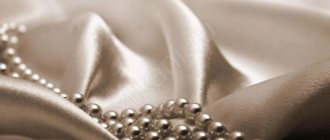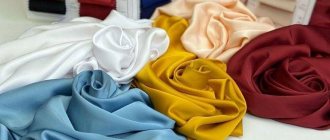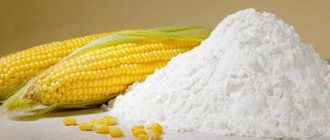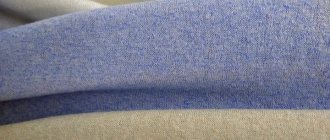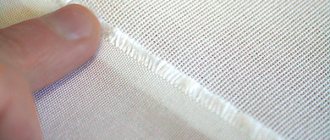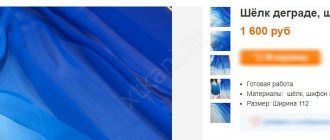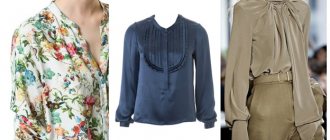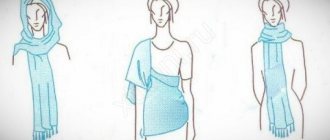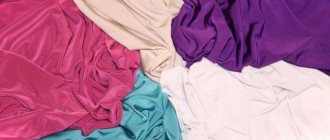Artificial silk fabric is a beautiful, worthy, high-quality replacement for natural linen. What would clothes look like if people didn't know silk? It is difficult to imagine a man's suit without a tie, a woman's neck without a scarf or headscarf, a skirt without thin feminine blouses. Over the past hundred years, material from the category of status fabric for high society balls and receptions has moved into the category of familiar things, without which our lives cannot be imagined.
A little history
Natural silk was created in China in ancient times from the cocoon of a silkworm butterfly. Legend has it that his wife came up with the Yellow Emperor, the father of the Celestial Empire. China, on pain of death, prohibited the export of eggs of these insects from the country. In the 6th century, Justinian, the ruler of Byzantium, wanted to get silkworm larvae. Missionary monks brought them to him in a bamboo stick.
The fabric made from this fiber is so good that throughout Europe, at royal courts, wearing silk clothes was considered a sign of belonging to the highest caste. It is no coincidence that, since the Middle Ages, scientists have tried to obtain a similar fiber artificially. This was only possible at the turn of the 19th and 20th centuries. The fiber was called viscose silk, and it was patented in 1902 in England.
Matter quickly conquered the whole world. In the second half of the 20th century, the production of synthetic silk began. Many people confuse these concepts, believing that they are the same thing. However, there is a difference in composition and properties between synthetic and viscose material.
Acetate thread - what is it?
The history of acetate fiber production began much later than in the case of viscose. Cellulose is used as a raw material, but it is pre-treated with acetic acid or anhydride. As a result, cellulose acetate dissolves in an acetone solution or in methylene chloride with the addition of ethyl alcohol. Exposure to these substances promotes the formation of threads necessary for the production of acetate or triacetate silk fibers, which have virtually no significant differences.
This fabric is characterized by a shiny surface, soft structure and elasticity. It is able to maintain its fold and not lose its former attractiveness even when wet or prolonged use. Nevertheless, the material accumulates static electricity, is non-hygroscopic, resists exposure to high temperatures and quickly dissolves in acetone. Nowadays, such a solution is losing its former demand and is practically going out of use. However, the production of such material is considered the most environmentally friendly and clean when compared with the production of many other artificial materials.
How fabric is made
The starting raw material is cellulose - a polysaccharide that is part of plant cells; it is obtained from wood. This is the difference between such material and synthetic ones. To avoid confusion, labeling rules prohibit calling the fiber rayon, but require it to be labeled as viscose or acetate. The production process is as follows:
- The crushed cellulose is exposed to alkali (caustic soda) and pressed.
- Pre-ripening. The resulting substance is crushed and left for some time to polymerize.
- Preparation of xanthate. The raw materials are placed in sealed containers filled with nitrogen.
- Dissolution of xanthate. The output is transparent viscous viscose, which is left to age.
- Liquid viscose is pressed through dies into a precipitation machine with a mixture of acids. Fibers are formed.
- The fibers are spun into threads. Textile factories use them to produce fabrics.
- An important step is the precipitation bath. The composition of the acids in it and the temperature completely determine the properties of the fiber and future fabrics. Manufacturers keep these parameters in the strictest confidence.
Secrets of production
To obtain an artificial material, the raw material must first be produced. To do this, wood crushed to chips is treated in a solution with the addition of alkali. The resulting gray mass is first bleached and then cardboard is created from it. Sheets of cardboard are further processed, and the final product is viscose.
Viscose chemical fibers are produced in the following way:
- Synthesis and primary processing;
- Production of spinning solution;
- Creation of threads;
- Fiber finishing;
- Drying.
Advantages and disadvantages
Externally, a thin artificial substitute is similar to natural fabric, but in its chemical and organoleptic properties it is closest to cotton. This is not surprising, since the basis of the fibers of both viscose and cotton is vegetable cellulose. Compared to analogues, the fabric has undoubted advantages:
- absorbs moisture well, hygroscopicity is twice as high as that of cotton;
- softness, comfortable tactility;
- ease;
- has a perfectly smooth texture;
- breathability is the same as cotton, lower than natural silk, but higher than synthetic;
- does not condense static electricity unlike synthetics;
- drapes well;
- The coloring is permanent and does not fade;
- hypoallergenic - unlike synthetic analogues, does not cause skin irritation and allergic reactions;
- durability - superior to natural silk and cotton.
In addition to its advantages, the fabric has some disadvantages compared to its natural counterpart:
- artificial material wrinkles; to eliminate this property, synthetic fibers are often added to its composition (usually polyester, less often polyamide or polyester);
- when wet, it deforms, loses elasticity, and can tear;
- It allows air to pass through worse than natural fabric;
- warms less;
- does not have a bactericidal effect.
How to distinguish artificial from natural?
If you remember what artificial silk is, and according to experts, in appearance it is almost no different from natural silk, you will still want to know how not to confuse them. After all, the price difference between materials is gigantic.
So, how to distinguish real silk from artificial, as well as from synthetic?
- Synthetics do not wrinkle at all. It does not allow air and moisture to pass through.
- The artificial composition is similar in properties to the natural one, but wrinkles more strongly and loses strength when wet;
- This fabric has more pronounced characteristics, and also warms in summer and cools in winter. It wrinkles and is afraid of heating.
Even if you know exactly how artificial silk differs from natural silk, down to the smallest details of the production process, there will always be a risk that you will not be able to distinguish the fabric by appearance. Here we will tell you how to wash silk items, be sure to read.
To find out for sure which sample you got into your hands, try setting fire to the thread:
- Natural silk smolders without supporting the flame. If you remove the match, the burning will stop. At the same time, the smell of burning hair or feathers is felt. The remaining material crumbles to dust;
- Artificial burns like paper - with a characteristic smell, smoke and flames. Raw materials quickly turn to ash;
- Synthetics melt, stink of plastic, and in the end you are left with a solid melted mass in your hands.
Areas of use
Their cellulose fibers produce several types of silk fabrics:
- viscose silk is a good quality imitation. Depending on the weaving technology, almost the entire range of traditional silks can be produced (satin, chiffon, gauze, organza, crepe, etc.);
- acetate silk is cellulose (mainly waste from the woodworking industry in the form of wood chips) treated with acetic acid. It wrinkles less, holds wrinkles, and does not deform when wet. At the same time, it does not absorb moisture and is electrified. In recent years, the material has been losing popularity;
- cupra – copper-ammonia fibers. In the technological cycle, copper sulfate and ammonia are used at the xanthate dissolution stage. This feature of the technology makes it possible to bring cupra as close as possible to its natural counterpart, making it more breathable, durable and elastic. The disadvantage of the fabric is its high price;
- Modal is a fabric made from eucalyptus cellulose. Possesses the bactericidal properties of the original tree. Used to produce high-quality expensive bed linen;
- Lyocell is a fabric that is practically no different from natural fabric. The price is high.
Artificial silk has found recognition and widespread use. It is used in sewing a wide variety of products.
- Bed linen made of artificial silk has an excellent appearance, while the price of the set is several times lower than that of a similar set made of natural fabric.
- All kinds of clothing - you can find attractive and practical blouses, scarves, stoles, scarves, and children's clothing on sale. Dresses made of artificial silk are especially in demand.
- Artificial silk underwear, elegant and very feminine dressing gowns are an extremely popular option; you can use this fabric to make a stylish and elegant set at a very reasonable price.
- Interior decoration - bedspreads and even carpets made of artificial silk are successfully complemented by curtains made of the same material.
Characteristics of artificial silk
The label “rayon” denotes a series of viscose fabrics made from wood waste, which are based on an acetate substance - cellulose acetate. A similar name also refers to some synthetic fabrics, and sometimes mixed fabrics, for example, smooth and shiny like silk. For example, you can take polycotton with a high content of cotton and polyester.
The labels of textile products or clothing items always indicate the type of fiber that was used in the production of the fabric. And although all artificial alternatives are practically no different in external similarities from natural fibers, there are significant differences in their composition and characteristics.
It is the composition of the fiber that determines its performance properties and comfort of use. For example: viscose is unable to electrify, and fabrics that were created on the basis of acetate threads accumulate a charge very quickly. Synthetic products are particularly slippery and cold, while viscose silk models keep you warm in winter and cool in summer due to their thermoregulatory properties.
To reduce the cost of silk fabric, its composition is saturated with additional compounds and chemical fibers. Naturally, the most elite solution remains pure viscose , which in all respects resembles its natural counterpart.
Product care
Artificial silk items require careful care:
- hand wash, or, as a last resort, machine wash in the “delicate wash” mode;
- The products cannot be twisted, you can squeeze them slightly and let the water drain on their own;
- dry in a horizontal, straightened position;
- iron with a low-heat iron.
The imitation of natural fabric, created as a result of advances in science and technology, made it possible to preserve all the advantages of the original plant material, its environmental friendliness, hypoallergenicity and friendliness towards humans, while the price of the fabric turned out to be quite affordable. This is the secret of the enduring popularity of this amazing material.
Advantages
Artificial silk is characterized by its thinness and airiness. Fine silk fabric has a glossy sheen, so smooth silk is very attractive. Clothing made from iridescent silk is very comfortable and retains its shape for a long time, because the material is made of high-quality fibers.
The advantages of artificial silk include:
- Softness and smoothness. It feels good to touch;
- Breathability, so clothes made of transparent silk will not be hot;
- Hygroscopicity. The output of sweating has a positive effect on the condition of the skin;
- Ease;
- Durability, so dense silk fabric is durable;
- It can be draped easily, so sewing clothes from this material is not difficult;
- Antistatic effect;
- Dye fastness. You can wash clothes either by hand or in a washing machine;
- Easy to care for.
Differences between acetate silk and viscose silk
Acetate and triacetate fibers are varieties of unnatural cellulose esters and acetic acid. Most often they are obtained for spinning yarn. They have their own characteristics and differences from viscose:
- viscose fibers are stronger;
- elasticity is most noticeable in triacetate, less in acetate;
- viscose threads are the most resistant to washing, but products made from them are more likely to shrink;
- acetate fiber transmits ultraviolet rays and can also dissolve in alcohol;
- acetate and triacetate have high electrification;
- The lightfastness of almost all is the same.
What acetate and triacetate fibers look like
Differences between viscose, polyester and natural fabric
These three types have their differences:
- artificial wrinkles more than synthetics, but in both options the leather breathes well;
- polyester is electrified;
- When viscose burns, it emits a gas that smells similar to burning paper. After burning, ashes remain;
- burning of synthetics occurs with the smell of burnt plastic, after which only a solid piece of the former material remains;
- When burned, natural silk does not form a flame, but the smell of burnt hair appears.
Viscose and polyester
